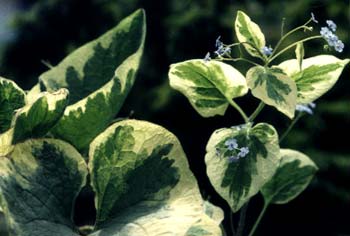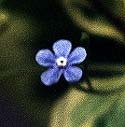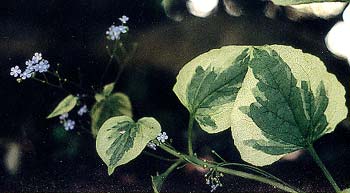
Creamsickle Brunnera, aka Variegated Siberian Bugloss, aka False Forget-me-Nots
Brunnera, native of the western Caucacus, loves deep shade. I put it in a moist humousy area overshadowed by a fountaining Fountaining Franchet's Cotoneaster & a 'Jelena' Witchhazel.
 This area already had a lot of low-growing flowers such as Dog Tooth Lilies & other spring woodland treasures that disappear in summer. The area needed something which would have a longer-lasting presence. The brunnera really dressed up that shady spot with its big spring-through-autumn foliage & its spring-through-summer wee teency forget-me-not flowers. The contrast of large leaves & tiny bright blue flowers is charming as can be. Planted very nearby are two varieties of Arum italicum which produce large arrowhead leaves in winter.
This area already had a lot of low-growing flowers such as Dog Tooth Lilies & other spring woodland treasures that disappear in summer. The area needed something which would have a longer-lasting presence. The brunnera really dressed up that shady spot with its big spring-through-autumn foliage & its spring-through-summer wee teency forget-me-not flowers. The contrast of large leaves & tiny bright blue flowers is charming as can be. Planted very nearby are two varieties of Arum italicum which produce large arrowhead leaves in winter.Even though the Brunnera persists a bit through winter in our mild climate, & doesn't look too winter-beaten if failing old leaves are trimmed as they wear out, it is nevertheless very slowly dying back in December & January. It would die back in October further north. The arrowhead leaves of the Arums fill in for it so that that patch of ground need not seem tawdry in the chilly season. Sometimes there are still some Brunnera leaves remaining in February, but should definitely be cut off by then to make room for the new leaves that are erupting. Our clump actually begins blooming by March 1st, even though the new leaves are still tiny.
Brunnera was named in 1851 for the 19th Century Swiss botanist Samuel Brunner. It was first collected by Dr. J. M. F. Adam who found it in woodlands north of Tiflis (Tbilisi) during the 1800 Caucasian Expedition of Count Mussin-Puschkin, & was initially assigned to the genus Anchusa. It has remained slow to gain popularity with gardeners, but demand from shade-gardeners has been sufficient that several cultivars to be developed. The one we have is Brunnera macrophylla 'Hadspen Cream' or Creamsickle Brunnera, a recipient of the Royal Botanical Society's carefully given Award of Garden Merit.
 Creamsickle Brunnera has big six-inch heart-shaped rather furry blue-green leaves with creamy pale yellow borders. It was developed at Hadspen Gardens in Somerset, England. It does not reproduce itself except through root division, which is slow & painstaking with this plant. This is quite different from the species plant itself, which self-sews easily & is quick to spread. It's not surprising then that 'Hadspen Cream' is only occasionally offered here in the Northwest, or I presume anywhere else either. It is not otherwise tricky to grow, so long as it never dries out or gets too much sun, & it will grow quite full & large as a single plant.
Creamsickle Brunnera has big six-inch heart-shaped rather furry blue-green leaves with creamy pale yellow borders. It was developed at Hadspen Gardens in Somerset, England. It does not reproduce itself except through root division, which is slow & painstaking with this plant. This is quite different from the species plant itself, which self-sews easily & is quick to spread. It's not surprising then that 'Hadspen Cream' is only occasionally offered here in the Northwest, or I presume anywhere else either. It is not otherwise tricky to grow, so long as it never dries out or gets too much sun, & it will grow quite full & large as a single plant.Eventually it will be necessary to dig up & divide any buglass, but that can be once every five to ten years. It meets some of the same gardening needs as do hostas, but without the susceptibility to slug attacks.